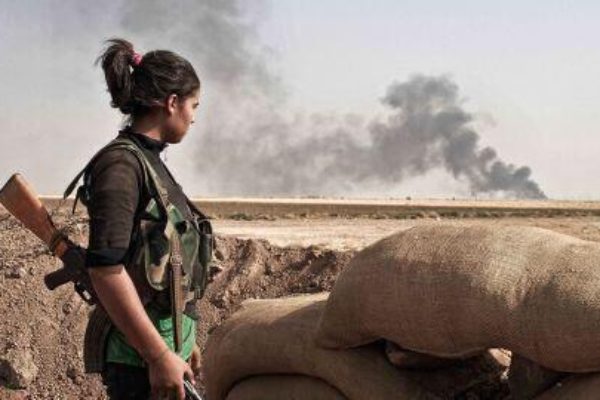The Changing Face of Female Identity in Today’s Conflict by Emily Daglish
Traditionally, the picture of a woman, or a girl in conflict has been much the same as a child – the victim, the non-combatant, the innocent and the helpless. Prevented from fighting, silenced by society and ignored on the wider stage, perhaps this face was not too far from most of their experiences. The last few decades however, particularly the conflicts we see today in Iraq and Syria, have challenged this – there is no longer one face of women in conflict. They are combatants and activists, refugees and businesswomen – our new age of technology allows us and them to better understand and utilise women’s role in conflict and also in the building of peace and of justice.
The continuous use of sexual violence as a weapon, predominantly against women and girls has been sometimes overlooked as just another brutal aspect of war. However, the almost medieval suffering of those living under and captured by Daesh in the past few years – historically captured by our new era of social media and almost universal communication, has brought the suffering of women and girls into a focus unheard of before. Despite the dominant classical interpretation that these women are purely victims, without agency or choice, has been disproved time and time again. This month, two Yazidi women who escaped sexual enslavement by so-called Islamic State (IS) in Iraq have won Europe’s top human rights award, the Sakharov prize[1]. These women – victims and refugees, with all the negative connotations this identity implies – chose to capitalise on and lengthen our short attention spans for change. Female suffering turned activism is not a new phenomenon, however, as the influence of women in Parliaments, media and society grows worldwide, their suffering is no longer an afterthought in peacetime, but a tool to inform, influence and change how conflicts are understood in real time. Their perspective is unique, not considered combatants their testimony means more, their concerns for humanity linger longer and impact more.
Seven year old Bana Alabed, a young Syrian girl tweeting of life in Aleppo, used what little was available to her to capture the hearts of internet users[2] worldwide – her humanity and fate such a concern that news outlets actively sought her safety. Her identity as a girl and as a child, in a conflict where her gender places her at unique risk, is a factor that has not been lost on her followers and the international community, so much so that her survival and humanity persistently brings attention back to the tragedy unfolding around her so that it cannot be forgotten.
Our communication age has given us a clearer picture of battlefields and their combatants, challenging our perception of the ‘soldier’ identity. Female Peshmerga fighters are perhaps the clearest example of how we have come to see women as combatants in modern irregular warfare – and successful ones at that. Greater access than ever before has enabled journalists and researchers to understand the complexities for female fighters, as well as their unique strengths – such information is critical not only to understanding current conflicts, but in learning lessons for the increasing role of women in front line conflict around the globe. Again, this is not a new phenomenon and in many ways we should be lambasted for portraying it as such – however, our increased awareness of the patriarchy and suffering inflicted on women and girls in today’s conflicts provides such a start contrast that it is surely worth highlighting the diverse achievements and capabilities of women living through conflict.
There is another side to current conflicts, in which the role of women is still overlooked – their ability to influence and inflame conflict. The social group nature of female communication has proved a critical tool in Daesh’s push to radicalise women and girls,[3] one that still holds a consistent influence and risk. Here, our historical perception of women as purely non-violent, peaceful and moderate voices for good is challenged as complacent and ill-informed by events of the past and present.
By ignoring the differences between women, we protect them poorly – these diverse identities of women in conflict are more visible today than ever before. Our ability to challenge, present and notice achievements and threats is more democratised than ever before. However, the challenges and threats to women’s lives and equality persists, not only in conflict zones. Conflict amplifies and scrutinises the best and worst of society, the international community must ensure that the changes women achieve during conflict are not resigned to the history books, but empowered and used to strengthen legislation, activism and policy so that lessons are learnt and not forgotten. TSRN’s work to empower women through sustainable initiatives and recovery mechanisms in the aftermath of conflict has built on these lessons and carries them across to our other areas of work, notably counter-extremism and reconciliation, where the role of women is no longer underestimated.
[1] http://www.europarl.europa.eu/sakharovprize/en/home/the-prize.html
[2] http://www.bbc.co.uk/news/world-middle-east-38209743
[3] http://www.hscentre.org/policy-unit/recruitment-isis-longer-mans-game-2/

